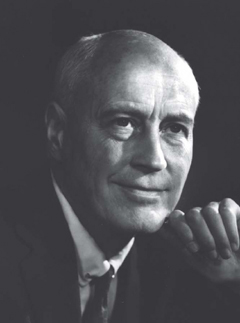Horace Magoun
- Birthdate
- 1907/06/23
- Birthplace
- Philadelphia, PA, USA
- Death date
- 1991/03/06
- Associated organizations
- University of California
- Fields of study
- Bioengineering
Biography
Horace “Tid” Winchell Magoun was an American neuroscientist known for his research on the central nervous system. Magoun formulated the principle that the specialized functions of the cerebral cortex require the input of subcortical systems that govern a range of activities between deep sleep and high vigilance. While serving as a professor of microanatomy at Northwestern University, Magoun, in collaboration with Italian Neurophysicist Giuseppe Moruzzi, identified the brain center responsible for sleep in 1948. Moruzzi and Magoun’s seminal paper, “Brain Stem Reticular Formation and Activation of the EEG,” published in Electroencephalography and Clinical Neurophysiology in 1949 described the ascending activating properties of the brain-stem reticular formation. In 1950, Magoun became the founding chair of the University of California, Los Angeles Department of Anatomy and in 1959 began the Brain Research institute at UCLA.
Horace Winchell Magoun was born on June 23, 1907, in Philadelphia, Pennsylvania, to Roy Winchell Magoun, an ordained Episcopalian Minster and the former Lucy Coe Perkins. The Magoun’s lived in several locations in New England before settling in Newport, Rhode Island in 1919. Magoun attended Rhode Island State College where he received a B.S. in Biology in 1929. He then earned a M.S. in Zoology from Syracuse University in 1931 and a Ph.D. in Anatomy from Northwestern University in 1934. In 1931, Magoun married a fellow Syracuse University graduate student, Jeanette Alice Jackson, with whom he had three children, James, Elizabeth, and Ann.
At the time Magoun began his doctoral work, the Institute of Neurology at Northwestern University Medical School was well known for its research of the hypothalamus. His dissertation, “The Central Path of the Pupilloconstricotor Reflex in Response to Light” reflected his research into the effects of stimulation of the hypothalamus gland on respiration and other motor functions. Upon earning his Ph.D., Magoun’s first appointment was at the Institute of Neurology at the Northwestern University Medical School in Chicago, IL, now the Feinberg School of Medicine, where he partnered with Stephen Walter Ranson. Magoun would eventually transfer to the Department of Anatomy at Northwestern University where he assumed teaching duties from 1941 to 1950.
In 1950, Stafford L. Warren invited Magoun to become the founding chairman of the Department of Anatomy at the University of California, Los Angeles, which began a four decade affiliation with the institution. Magoun went on to start the Brain Research Institute on the UCLA campus in 1959. The interdisciplinary research center—the first of its kind in the United States—promoted neuroscience as a distinctive research discipline. While continuing his role as an influential researcher, Magoun served as dean of the Graduate Division at UCLA from 1962 to 1972 where he championed the recruitment of qualified women and minorities into the tenured ranks of the university. He continued this work after his retirement in 1972 as the director of the fellowship office of the National Research Council in Washington, D.C. from 1972 to 1974.
Magoun returned to UCLA in 1974 as an emeritus professor in the Department of Psychiatry. In this role, he helped develop the department’s Division of Biobehavioral Sciences. With the assistance of Louise H. Marshall, Magoun co-founded the Neuroscience History Resource Program (later becoming the UCLA Neuroscience History Archives) in 1980 to trace the history of discoveries linking the nervous system and behavior.
Magoun served on several private and federal health advisory committees and councils, including three of the National Institutes of Health. He was also a member of the National Academy of Sciences, the American Academy of Arts and Sciences, the American Association of Anatomy (president, 1964), the American Physiological Society, and The Society of Neuroscience among several other professional organizations.
Magoun wrote 250 publications, among which, is his best known monograph The Waking Brain, published in 1958. The highly acclaimed work examines the ascending reticular system and its ramifications, which greatly enhanced our understanding of the linkages between the brain and behavior.
After a series of small strokes, Magoun died in Santa Monica, California, on March 6, 1991.
Further Reading
Papers of Horace Winchell Magoun – Archival Collection spanning 1963 to 1972 housed by the UCLA Library, Department of Special Collections Manuscripts Division, Los Angeles, CA. The collection consists of papers, published articles, comments at professional conferences, and letters. Finding Aid
Magoun, Horace Winchell. The Waking Brain. Springfield, IL: Thomas, 1958.
Magoun, Horace Winchell and Louise H. Marshall. American Neuroscience in the Twentieth Century: Confluence of the Neural, Behavioral, and Communicative Streams. New York: Routledge, 2003.
Moruzzi, G. and H.W. Magoun. "Brain Stem Reticular Formation and Activation of the EEG," Electroencephalography and Clinical Neurophysiology, 1949, 1, 455-473.
References
Horace Winchell Magoun: A Biographical Memoir by Louise H. Marshall (Washington D.C.: National Academy of Sciences, 2004)
Horace W. Magoun, Ph.D., prepared by the Neuroscience History Archives, Brain Research Institute, UCLA
